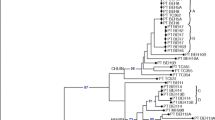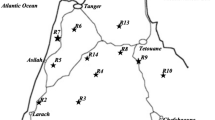Abstract
The genetic diversity of European species of Miscanthus was analyzed by AFLP technique. The genetic similarity based on six primer combinations yielded about 200 data points. The plant material included 11 clones of M. sinensis, 2 clones of M. sacchariflorus and 31 accessions of M. x giganteus. Furthermore 4 hybrids were created by crossing M. sinensis with M. sacchariflorus clones. Two clusters were found represented by M. sinensis and M. sacchariflorus clones. The M. x giganteus accessions clustered under M. sacchariflorus. A very low genetic diversity was found in the M. x giganteus pool. No polymorphism was detected between micro- and rhizome-propagated M. x giganteus accessions. Many of the M. sacchariflorus clones sampled in Botanical Gardens turned out to be M. x giganteus clones. In the hybridization of M. sinensis and M. sacchariflorus material, self-fertilization of the M. sinensis clones was determined by application of the AFLP technique. In the M. sinensis pool a typical diversification of hybrids was detected according to ornamental selection by horticulture breeders. The AFLP technique is an adequate and powerful tool to evaluate genetic diversification, to analyse the success of hybridizations and to find wrong classifications.
Similar content being viewed by others
References
Adati, S., 1958. Studies on the genus Miscanthus with special reference to the Japanese species suitable for breeding purpose as fodder crops. Bulletin Faculty Agricultural Mie University 17: 1-112.
Adati, S. & I. Shiotani, 1962. The syntaxonomy of genus Miscanthus and its phylogenic status. Bulletin Faculty Agricultural Mie University 25: 1-24.
Arumuganathan, K. & E.D. Earle, 1991. Nuclear DNA content of some important plant species. Plant Molecular Biology Reporter 9: 208-218.
Becker, J., P. Vos, M. Kuiper, F. Salamini & M. Heun, 1995. Combined mapping of AFLP and RFLP markers in barley. Molecular General Genetics 249: 65-73.
El Bassam, N.,M.Dambroth & I. Jacks, 1992. DieNutzung von Miscanthus sinensis (Chinaschilf) als Energie-und Industriegrundstoff. Landbauforschung Völkenrode 42: 199-205.
Folkertsma, R.T., J.N.A.M. Roupe van der Voort, K.E. de Groot, P.M. van Zandvoort, A. Schots, F.J. Gommers, J. Helder & J. Bakker, 1996. Gene pool similarities of potato cyst nematode populations assessed by AFLP analysis. Molecular Plant-Microbe Interactions 9: 47-54.
Glaszman, J.C., Y.H. Lu & C. Lanaud, 1990. Variation of nuclear ribosomal DNA in sugarcane. Journal of Genetic and Breeding 44: 191-198.
Greef, J.M. & M. Deuter, 1993. Syntaxonomy of Miscanthus x giganteus GREEF et DEU. Angewandte Botanik 67: 87-90.
Greef, J.M., R. Pude, H. Rennebaum, K.-U. Schwarz & W. Diepenbrock, 1994. Development of above-and underground organs of Miscanthus x giganteus in Northern Germany. In: Hennink, S., van Soest, L.J.M., Pithan, K. & Hof L. (Eds.), Alternative oilseed and fibre crops for cool and wet regions of Europe, pp. 101-112. COST 814, Office for Official Publications of the European Communities, Luxembourg.
Gower, J.C., 1972. Measures of taxonomic distance and their analysis. In: Weiner, J.S. & Huizinger, J. (Eds.), The assessment of population affinities in man, pp. 1-24. Clarendon Press, Oxford.
Hartley, W., 1958. Studies on the origin, evolution, and distribution of Gramineae 1. The tribe Andropogoneae. Australian Journal of Botany 6: 116-128.
Hirayoshi, I., K. Nishikawa & R. Kato, 1955. Cytogenetical studies on forage plants. 4. Self-incompatibility in Miscanthus. Japanese Journal of Breeding 5: 19-22.
Huang Y.-J. & C.-Y. Kwo, 1985. Flowering control by long-day treatment and leaf trimming in sugarcane. Republic Taiwan Sugar Research Institute 110: 1-12.
Jabs, U., 1995. Zytologische Untersuchungen der Chromosomen verschiedener Formen der Gattung Miscanthus. Thesis, University Hohenheim.
Lafferty, J. & T. Lelley, 1994. Cytogenetic studies of different Miscanthus species with potential for agricultural use. Plant Breeding 113: 246-249.
Lee, Y.L., 1964. Taxonomic studies on the genus Miscanthus. (3). Relationship among the section, subsection and species. Journal of Japanese Botanic 38: 197-205.
Linde-Laursen, I., 1993. Cytogenetic analysis of Miscanthus "Giganteus", an interspecific hybrid. Hereditas 119: 297-300.
Matumura, M., T. Hasegawa & Y. Saijoh, 1987. Ecological aspects of Miscanthus sinensis var. condensatus, M. sacchariflorus, and their 3x-and 4x-hybrids. III. Aboveground standing crop and response to cutting. Research Bulletin Faculty of Agricultural Gifu University 52: 315-324.
Meksem, K., D. Leister, J. Peleman, M. Zabeau, F. Salamini & C. Gebhardt, 1995. A high resolution map of the vicinity of the R1 locus on chromosome V of potato based on RFLP and AFLP markers. Molecular General Genetics 249: 74-81.
Mun, H.T., 1988. Comparisons of the primary production and nutrients absorption by a Miscanthus sinensis community in different soils. Plant & Soil 112: 143-149.
Mutoh, N., K.H. Yoshida, Y. Yokoi, M. Kimura & K. Hogetsu, 1968. Studies on the production processes and net productivity of a Miscanthus-sacchariflorus-community. Japanese Journal of Botany 20: 67-92.
Nei, M., & W.-H. Li, 1979. Mathematical model for studying genetic variation in terms of restriction endonucleases. Proceeding of the National Academy of Science USA 76: 5269-5273.
Numata, M. & M. Mitsudera, 1969. Efficient environmental factors in the growth and production of Miscanthus sinensis grasslands in JapanEcological judgement of grassland condition and trend. Japanese Journal of Botany 20: 135-151.
Rohlf, F.J., 1989. NTSYS-pc numerical taxonomy and multivariate analysis system. Exeter, New York
Saghai-Maroof, M.A, K.M. Soliman, R.A. Jorgensen, & R.W. Allard, 1984. Ribosomal DNA spacer-length polymorphisms in barley: Mendelian inheritance chromosomal location and population dynamics. Proceedings National Academy Science USA 81: 8014-8018.
Schondelmaier, J., G. Steinrücken & C. Jung, 1996. Integration of AFLP markers into a linkage map of sugar beet (Beta vulgaris L.). Plant Breeding 115: 231-237.
Schwarz, K.-U., J.M. Greef & E. Schnug, 1995. Etablierung und Biomasseproduktion von Miscanthus x giganteus unter verschiedenen Umweltbedingungen. Sonderheft Landbauforschung Völkenrode 155.
Smith, S., S. Luk, B. Sobral, S.Muhawish, J. Peleman & M. Zabeau, 1994. Associations among inbred lines of maize using RFLP and DNA amplification technologies (AFLP and AP-PCR), and correlations with pedigree, F1 yield and heterosis. Maize Genetics Newsletter. 68: 45.
Thomas, C.M., P. Vos, M. Zabeau, D.A. Jones, K.A. Norcott, B.P. Chadwick & J.D.G. Jones, 1995. Identification of ampli-fied restriction fragment polymorphism (AFLP) markers tightly linked to the tomato Cf-9 gene for resistance to Cladosporium. Plant Journal 8, 785-794.
van de Werf, H.M.G., W.J.M. Meijer, E.W.J.M. Mathijssen & A. Darwinkel, 1993. Potential dry matter production of Miscanthus sinensis in the Netherlands. Industrial Crops & Products 1: 203-210.
van Eck, H.J., J.R. van der Voort, J. Draaistra, P. van Zandvoort, E. van Enckevort, B. Segers, J. Peleman, E. Jacobsen, J. Helder & J. Bakker, 1995. The inheritance and chromosomal localization of AFLP markers in a non-inbred potato offspring. Molecular Breeding 1: 397-410.
von Wühlisch, G., M. Deuter & H.-J. Muhs, 1993. Identifizierung verschiedener Miscanthus-Sorten mittels Isoenzymen. Journal of Agronomy & Crop Science 172: 247-254.
Vos, P., R. Hogers, M. Bleeker, M. Reijans, T. Vandelee, M. Hornes, A. Frijters, J. Pot, J. Peleman, M. Kuiper & M. Zabeau, 1995. AFLP: a new technique for DNA fingerprinting. Nucleic Acids Research. 23: 4407-
Zeidler, A., Schneider, S., C. Jung, A.E. Melchinger & P. Dittrich, 1994. The use of DNA fingerprinting in ecological studies of Phragmites australis (Cav.) Trin. ex. Steudel. Botanica Acta 107: 237-242.
Zheng, X.H. & H. Cheng, 1989. The progressive aspects of silver grass and reed in Hubei Province. Journal Huazhong Agricultural University 6: 11-14.
Author information
Authors and Affiliations
Rights and permissions
About this article
Cite this article
Greef, J., Deuter, M., Jung, C. et al. Genetic diversity of European Miscanthus species revealed by AFLP fingerprinting. Genetic Resources and Crop Evolution 44, 185–195 (1997). https://doi.org/10.1023/A:1008693214629
Issue Date:
DOI: https://doi.org/10.1023/A:1008693214629




